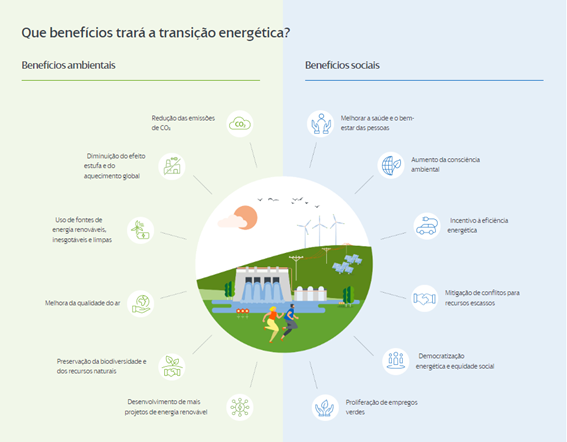
Energy Transition
The energy transition is essential to limit global warming to 1.5 degrees Celsius, requiring the expansion of renewable energies and the reduction of fossil fuels, in addition to bringing economic and social benefits, including job creation and gender equity.
Scientists from around the world warn: global warming of 1.5 degrees Celsius above the pre-industrial period could have serious consequences, including food insecurity and the disappearance of species. The increase in temperature is impacted by greenhouse gas (GHG) emissions, especially carbon dioxide (CO₂) and methane, resulting from activities such as the extraction and production of fossil fuels - oil, coal and natural gas. This means that, from the consumption of plastic to coal burning for electricity generation, the habits of people and businesses can contribute to climate change.
However, in its most recent report on mitigations, published in April 2022, the Intergovernmental Panel on Climate Change (IPCC) reinforced that, despite the tragic scenario, it is still possible to halve emissions by 2030. The energy sector is most responsible for global emissions, so governments, companies and civil society organizations must take action to promote more sustainable policies in this market.
What is an energy transition?
The low-carbon energy transition is based on the expansion of energy from renewable sources, the reduction of fossil fuel use, and a focus on energy efficiency and technology investments. This is a concept aimed at transforming the energy matrix into less polluting solutions.
The IPCC guidelines also include increasing access to electricity for all people and the use of alternative fuels, such as renewable hydrogen (blue or green). Other possibilities that have been adopted are energy storage and initiatives to remove or offset emitted carbon, including carbon capture or trading in the carbon market.
How should the energy transition take place?
In its report on mitigations, IPCC proposes three routes for the expansion of sustainable energy:Decarbonize primary energy and electricity generation;
from low-carbon sources;
Limit energy use by improving efficiency and conservation.
This process has benefits such as stimulating the creation of a new economy and the generation of jobs. According to the International Labor Organization (ILO), measures for a more sustainable energy sector could bring net gains of approximately 24 million jobs by 2030. In addition, renewable energies bring a scenario with more income and gender equity; according to the International Renewable Energy Agency (IRENA), women account for one-third of jobs in renewables, a better scenario than in oil and gas.
What is a fair energy transition?
A fair transition is a need recognized by several international organizations and, according to IPCC, involves adopting measures to ensure that the impacts caused by changes in energy technologies are minimized and the benefits are expanded. Some of the main topics include eradicating poverty, regulating prosperity, and creating jobs in green sectors. These actions must consider local possibilities and can be aligned with the SDGs.

Energy transition in Brazil
In Brazil, the electricity and energy matrices have a higher share of clean and renewable sources than in the rest of the world - while in the country 46% of energy comes from these sources, globally this percentage drops to 14%; considering electricity, the figures are 83% and 27%, respectively. The main domestic source is water, which accounts for more than half of the country's installed capacity, followed by wind power.
The Energy Research Company (EPE), responsible for the studies that support the sector planning in Brazil, affirms that one of the country's greatest challenges is the transportation sector. Initiatives to reduce emissions include encouraging the use of biofuels, such as ethanol (obtained from sugarcane) and biodiesel (from vegetable oils), and electric vehicles.
Neoenergia's role in Brazil's energy transition
Neoenergia's strategy and business model were designed anticipating the role that the electricity sector can play in combating climate change and in creating opportunities for economic, social and environmental development. The company is a pioneer in the national energy transition and is committed to leading this process, prioritizing decarbonization, decentralization and digitization of networks.
Neoenergia started operating its first wind complex in 2006, one of the first in Brazil. The company’s focus is the supply of renewable energy. Considering assets in operation and under construction, the company has 44 wind farms, 7 power electric plants and 2 solar farms. It is investing in new generation models, promoting offshore wind and green hydrogen projects in states such as Rio Grande do Sul, Rio de Janeiro and Pernambuco.
The company also encourages innovation through its Research and Development (R&D) program, regulated by the National Electric Energy Agency (ANEEL). Among the projects are the installation of microgrids to supply an isolated community in the countryside of Bahia. In terms of electric mobility, the installation of the Green Corridor, an eletric road, which provides charging infrastructure along a 1,200-kilometer stretch between Bahia and Rio Grande do Norte, and the Green Trail, an initiative to promote environmentally sustainable applications for the island of Fernando de Noronha (PE), stands out.
News
2025-12-12
Prêmio Brasil Olímpico 2025: Neoenergia reforça compromisso com esporte feminino no país
2025-12-09
Prêmio Aberje 2025: Neoenergia é campeã nacional com campanha sobre segurança na rede elétrica com Carlinhos Brown
2025-12-01
Exclusivo a mulheres negras, Prêmio Inspirar 2025, do Instituto Neoenergia, anuncia vencedoras em quatro estados e no DF
2025-11-27
Neoenergia e Honda se unem para acelerar uso do hidrogênio verde na mobilidade brasileira
2025-11-25
